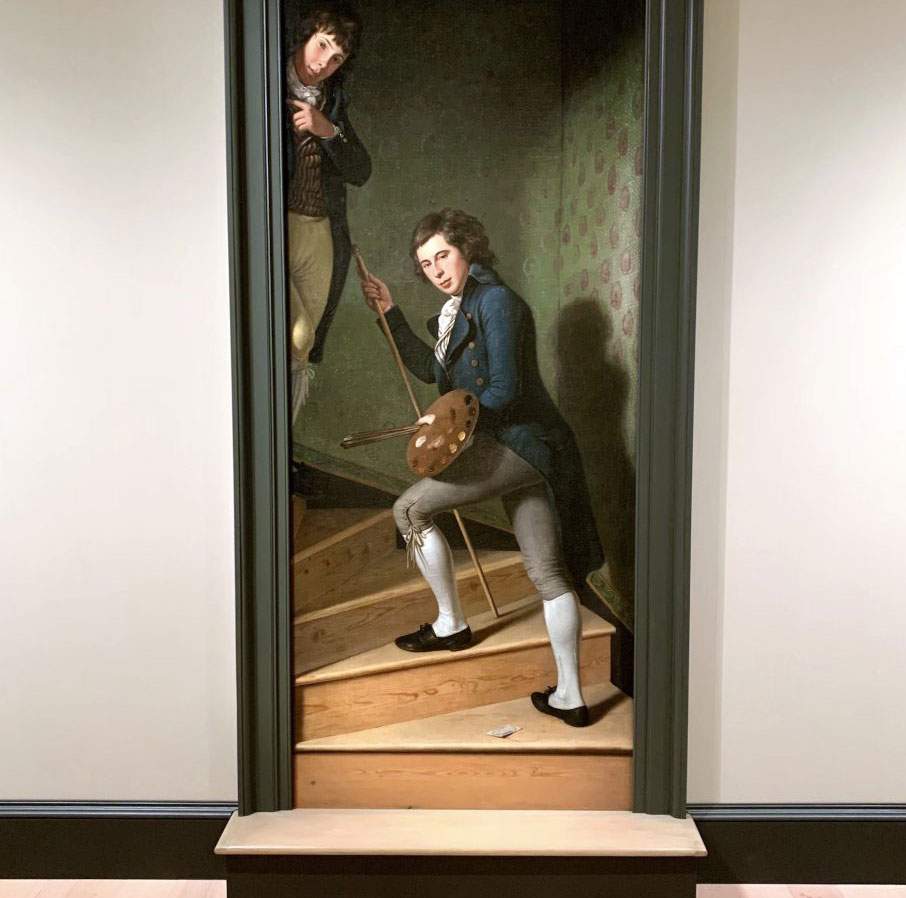The Philadelphia Museum of Art holds in its collection a trompe-l’oeil painting of early American art that holds some surprises: it is The Staircase Group made by Charles Willson Peale, an American artist known for his portraits of famous figures such as Benjamin Franklin and George Washington (of the latter he completed about sixty portraits). Born in 1741 in what is now Maryland, Peale was a soldier, scientist, inventor, and above all an educator; during his youth he devoted himself to experimenting, first as a saddlemaker, then as a watchmaker, and finally as a painter.
In the 1795 painting, the artist depicted two of his sons, Raphaelle and Titian, like the two celebrated Italian artists, as they climb a narrow staircase decorated with wallpaper, dressed according to the fashion of the time. They both look at the viewer as if to invite him or her to follow them, and in addition, a real step has been added to the base of the painting that further enhances the illusion of being able to enter the painting.
But what surprises does the painting hold? The work was created specifically for an exhibition at the Pennsylvania State House that marked the establishment of the nation’s first art academy, the Columbianum. The artist’s role had been pivotal in founding the academy: he firmly believed that aspiring American artists could be trained in Philadelphia even without traveling to European academies. At the time of the painting’s execution, his eldest son Raphaelle was already a painter in his own right (he indeed holds a palette and brush), and through the work his father intended to represent the rise of American art symbolized by the young artist metaphorically climbing the ladder.
Another particular detail is the paper ticket that seems to have slipped from Raphaelle’s pocket: it is actually an invitation addressed to the public, as it is an entrance ticket to the Peale Museum. Charles Willson Peale had in fact established his museum at Philosophical Hall, a building near the Pennsylvania State House, now known as Independence Hall: not an art museum in the strict sense, but a kind of miniature world, where various scientific and natural specimens were displayed in addition to portraits. Probably, according to some historians, the gesture of the youngest son, Titian, pointing to the staircase signifies an invitation to the viewer to visit his father’s museum.
The Philadelphia Museum claims that many viewers were fooled by the illusion of the presence of a staircase, complicit in the frame surrounding the canvas and the step at the base: among them, possibly George Washington, according to the account of Rembrandt Peale, another son of the artist. Scholars have recently debated the latter’s account. However, that observers fall for the deception of illusion would be evidenced by the presence on the canvas of circular craquelure, a conservation problem provoved, in most cases, by people reaching out to touch the canvas surface. A sign documenting Peale’s skill in creating a trompe-l’oeil.
Ph.Credit Ben Davis
 |
| A step invites you into the painting: the trompe-l'oeil fooled even George Washington |
Warning: the translation into English of the original Italian article was created using automatic tools. We undertake to review all articles, but we do not guarantee the total absence of inaccuracies in the translation due to the program. You can find the original by clicking on the ITA button. If you find any mistake,please contact us.